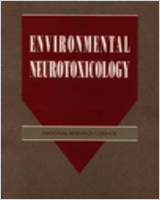NCBI Bookshelf. A service of the National Library of Medicine, National Institutes of Health.
Scientists agree that exposure to toxic agents in the environment can cause neurological and psychiatric illnesses ranging from headaches and depression to syndromes resembling parkinsonism. It can even result in death at high exposure levels. The emergence of subclinical neurotoxicity--the concept that long-term impairments can escape clinical detection--makes the need for risk assessment even more critical.
This volume paves the way toward definitive solutions, presenting the current consensus on risk assessment and environmental toxicants and offering specific recommendations.
The book covers:
- The biologic basis of neurotoxicity.
- Progress in the application of biologic markers.
- Reviews of a wide range of in vitro and in vivo testing techniques.
- The use of surveillance and epidemiology to identify neurotoxic hazards that escape premarket screening.
- Research needs.
Contents
- Committee on Neurotoxicology and Models for Assessing Risk
- Board on Environmental Studies and Toxicology
- Commission on Life Sciences
- Preface
- Executive Summary
- 1. Introduction: Defining the Problem of Neurotoxicity
- 2. Biologic Basis of Neurotoxicity
- 3. Biologic Markers in Neurotoxicology
- 4. Testing for Neurotoxicity
- 5. Surveillance to Prevent Neurotoxicity in Humans
- 6. Risk Assessment
- 7. Conclusions and Recommendations
- References
NOTICE: The project that is the subject of this report was approved by the Governing Board of the National Research Council, whose members are drawn from the councils of the National Academy of Sciences, the National Academy of Engineering, and the Institute of Medicine. The members of the committee responsible for the report were chosen for their special competencies and with regard for appropriate balance.
This report has been reviewed by a group other than the authors according to procedures approved by a Report Review Committee consisting of members of the National Academy of Sciences, the National Academy of Engineering, and the Institute of Medicine.
The National Academy of Sciences is a private, nonprofit, self-perpetuating society of distinguished scholars engaged in scientific and engineering research, dedicated to the furtherance of science and technology and to their use for the general welfare. Upon the authority of the charter granted to it by the Congress in 1863, the Academy has a mandate that requires it to advise the federal government on scientific and technical matters. Dr. Frank Press is president of the National Academy of Sciences.
The National Academy of Engineering was established in 1964, under the charter of the National Academy of Sciences, as a parallel organization of outstanding engineers. It is autonomous in its administration and in the selection of its members, sharing with the National Academy of Sciences the responsibility for advising the federal government. The National Academy of Engineering also sponsors engineering programs aimed at meeting national needs, encourages education and research, and recognizes the superior achievements of engineers. Dr. Robert M. White is president of the National Academy of Engineering.
The Institute of Medicine was established in 1970 by the National Academy of Sciences to secure the services of eminent members of appropriate professions in the examination of policy matters pertaining to the health of the public. The Institute acts under the responsibility given to the National Academy of Sciences by its congressional charter to be an adviser to the federal government and, upon its own initiative, to identify issues of medical care, research, and education. Dr. Kenneth Shine is president of the Institute of Medicine.
- NLM CatalogRelated NLM Catalog Entries
- Strategies for the prevention of environmental neurotoxic illness.[Environ Res. 1993]Strategies for the prevention of environmental neurotoxic illness.Landrigan PJ, Graham DG, Thomas RD. Environ Res. 1993 Apr; 61(1):157-63.
- Prenatal screening for fetal aneuploidy in singleton pregnancies.[J Obstet Gynaecol Can. 2011]Prenatal screening for fetal aneuploidy in singleton pregnancies.Chitayat D, Langlois S, Douglas Wilson R, SOGC GENETICS COMMITTEE, CCMG PRENATAL DIAGNOSIS COMMITTEE. J Obstet Gynaecol Can. 2011 Jul; 33(7):736-750.
- Review Health-related disparities: influence of environmental factors.[Med Clin North Am. 2005]Review Health-related disparities: influence of environmental factors.Olden K, White SL. Med Clin North Am. 2005 Jul; 89(4):721-38.
- American Society of Clinical Oncology policy statement update: genetic testing for cancer susceptibility.[J Clin Oncol. 2003]American Society of Clinical Oncology policy statement update: genetic testing for cancer susceptibility.American Society of Clinical Oncology. J Clin Oncol. 2003 Jun 15; 21(12):2397-406. Epub 2003 Apr 11.
- Review Environmental Epidemiology: Volume 1: Public Health and Hazardous Wastes[ 1991]Review Environmental Epidemiology: Volume 1: Public Health and Hazardous WastesNational Research Council (US) Committee on Environmental Epidemiology. 1991
- Environmental NeurotoxicologyEnvironmental Neurotoxicology
Your browsing activity is empty.
Activity recording is turned off.
See more...
